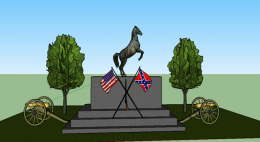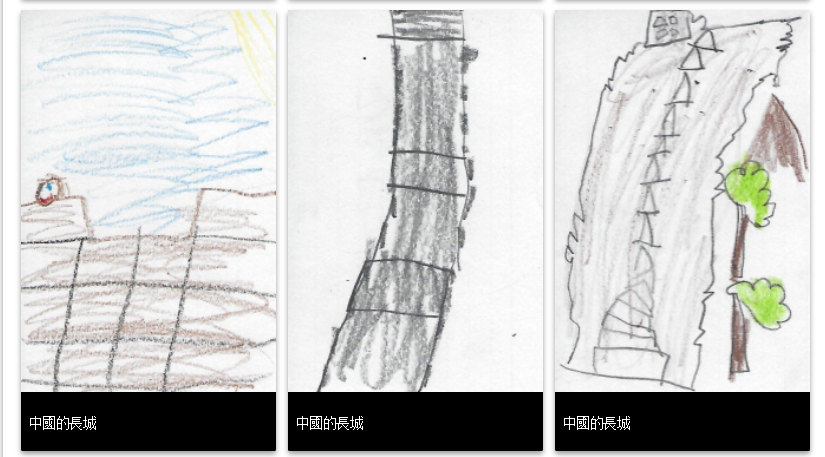Dan Dickey and Beth Berry, Deep Run High School
This lesson is for : Grade 11:
Summary
Students in AP Language read, annotate, and discuss six documents related to the history of Richmond, Virginia’s Monument Avenue. The students synthesize these documents and develop a thesis with accompanying support that answers the question, “How does a community effectively memorialize its “collective past” and/or history?” These essays are shared via GoogleDocs with groups of two to three AP US History students. The history students read the English student’s essays and use the recommendations within the essays, their knowledge of the Civil War (based on the classroom activities within the Civil War unit), and additional research in order to plan and design a monument that celebrates the 150th anniversary of the Civil War. These monuments and the student justifications for their content, design, and location are recorded in a Google Map and shared back with the English students. The English students play the role of Richmond’s City Council and decide which monument to fund and develop. At the end of the unit, all involved students participate in a Q&A session with sculptor Paul DiPasquale, who designed and created the Arthur Ashe statue on Monument Avenue. The students use Google Moderator to develop relevant questions for Mr. DiPasquale based on their experiences within this unit.
TIPC Ratings
Research & Information Fluency
Rating: Ideal – Explanation: Research and information fluency are a focus for both the English and History students involved in this lesson. AP Language students develop a thesis and support this thesis based on the six documents provided in the Document Based Question (DBQ). The essay that these students create is a synthesis essay, in which they evaluate the documents based on author, purpose, and context and then assemble and organize information from the documents to support their own unique answer to the essay question. These essays are shared via GoogleDocs with the AP US History students, who in turn must practice their information fluency skills.
At the beginning of the lesson, The AP US History Students complete research on a Civil War monument of their choice and upload this information to a Google Map. This basic research prepares the students for the research that they will complete later in the assignment. Based on the criteria of the English essay they receive, The AP US History students design a monument to memorialize the Civil War. The History students develop research topics and questions in order to select the ideal historic topic and/or individual that fulfills the requirements detailed within the English consultant’s essay. History students use a variety of search engines to locate relevant and authoritative information that explains and justifies their choice of monument topic, location, and design. This information, along with a picture of the monument is displayed via Google Maps Engine Lite, so that the English students (and Mr. Paul Dipasquale) can interact with this information, visualize the locations of these monuments, and evaluate which monument should be funded.
There are a variety of authentic aspects within this particular assignment. The documents within the initial DBQ were selected to make the task more relevant for students. Not only is Monument Avenue related to the Civil War, but it is also a local landmark for which many students have prior knowledge and experience. Additionally, the task to create a monument is relevant because this year marks the 150th anniversary of the Civil War. Although Richmond is not necessarily building a new monument, a number of events have been in the news regarding this historic anniversary.
Communication & Collaboration
Rating: Ideal – Explanation: Ideal
Students in this activity form teams and organize roles in order to design and create a Monument to memorialize the 150th anniversary of the Civil War. There are two distinct roles/teams within this particular assignment – The English students act as consultants and the history students act as the monument designers. This separation of roles allows the students to see how tasks of this nature require input from a variety of groups and are often difficult and time-consuming to complete due to varying perspectives. This separation of roles also allows for the assignment to be truly collaborative, as the final product cannot be completed without the work of either group. At the end of the assignment, after the monuments have been evaluated and the “winner” has been announced to the English and history classes, students complete reflection questions that allow them to discuss the collaborative aspects from the lesson and their connection to “real-world” collaboration.
Google Docs, Google Maps Engine, and Google Moderator are all used as tools to enhance the communication and collaboration process within this assignment. Google Docs allows the English consultants to review each other’s essays and then easily share their essay with the history students. Google Maps Engine allows the history students to share their research with the English consultants and experts (Mr. DiPasquale). Finally, Google Moderator allows the students to collaboratively create and vote on discussion questions for the Question and Answer session with Mr. Paul DiPasquale and then share these questions with Mr. DiPasquale before his visit.
Critical Thinking & Problem Solving
Rating: Ideal – Explanation: The authentic task that serves as a problem for this lesson is for students to design a monument in Richmond, Virginia that memorializes the Civil War. English students justify their decision about how to effectively memorialize a community’s past based on six documents provided in a DBQ. History students justify the topic, location, and design of their final monument based on the research that they complete, along with the recommendations of the English student’s essays. The final monuments and justifications are put into a Google Map, which allows the English students to visualize the location of these monuments and whether or not these monuments would be accepted by the community of Richmond, Virginia. The English students use a Google Form to evaluate each of the monuments, and the accompanying spreadsheet tabulates this information to determine an overall “winning” monument that will be funded by Richmond’s City Council.
Creativity & Innovation
Rating: Ideal – Explanation: In the first part of the lesson, English students analyze the documents within the DBQ and create their own solution to the authentic task of designing a monument that memorializes the Civil War. The history students synthesize the consultant essays and their historical research in order to design and create a monument that reflects the consultant’s criteria. Although the students
must follow the consultant’s criteria, they must also take risks by choosing a topic, location, and artistic design that is not specifically laid out for them. History students use a variety of digital tools to complete the monument design, including Blender, Google Sketchup, Photoshop, and other digital image editing software.







